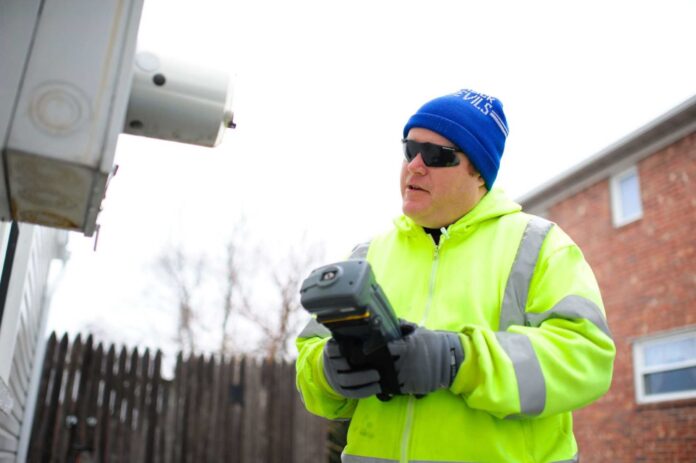You probably don’t see them. You probably don’t hear them, either.
Perhaps the only evidence of their presence is the sudden cacophony of dog barks shaking the neighborhood. But once a month — whether the air chills or stifles — meter readers stop by your house.
Sean Lynott, who reads meters for FirstEnergy’s Toledo Edison, has been at it for nine years. He is one of about 35 employees who check 308,000 meters in the Toledo area.
A typical day starts at 7:30 a.m. It’s the time to don a bright yellow jacket with silver reflectors. He and three other readers gather for their safety briefing meeting. Some days they talk about preventing slips, trips or falls.
Today the talk covers the ultimate four-legged enemy: dogs. Meter reader Brent Throne recalls a dog busting through a screen door and chasing him down Nebraska Avenue. Bryan Wilber, another reader, tripped over a rock and broke his wrist in an attempt to escape from one once.
The meeting closes and the four are off to a full day of driving and parking. Walking and stopping. Entering numbers into their hand-held computers.
Today the crew canvasses the suburban neighborhoods sprawling away from I-280 in Northwood. Dog attacks are few and far between here, so the biggest hurdle is the frosty air. Or, for Lynott, the occasional grill that blocks the view of the meter. Or the shrub that shrouds the meter’s numbers. Or a wooden gate with corroded hinges, resisting any kind of movement. And don’t get him started on bungee cords that hold gates together.
By 8:40 a.m., Lynott is just miles from headquarters. On a 21 day cycle, he has basically memorized the neighborhoods he canvasses. It’s not that he has to; the computer device he carries tells him where the meter is located on each house and announces whether there is a dog on the premises.
These computers make his job easier. But other kinds of technology might make his job obsolete.
He pulls into a driveway and hops out of his vehicle. Crunching down the frozen grass, he passes a few fake deer that have nose dived under the weight of winter. A plastic pig watches from behind a low fence. A couple of lawn gnomes sit around the yard’s sidewalk, their painted cloaks scabbed and chipped. He likes to see these quirks — to observe the various ways that people lay out their souls on the lawn or hang up their habits on brick and mortar.
But the Bureau of Labor Statistics predicts that meter reading jobs will decline rapidly. In 2008, the job employed about 45,300 meter readers. By 2018, there might be 36,300 left . That’s a 20 percent decreases, according to the bureau’s website.
Automatic meter reader systems are being installed all across the country. Columbia Gas of Ohio has outfitted Toledo with the new technology as part of a project that began in 2009 that has brought 24 more employees on board to equip 1.4 million meters.
They operate on a lithium battery that lasts for 20 years and transmit radio signals to a device that a meter reader would have as he or she drives past, said Chris Kozak, communications and community relations manager for Columbia Gas of Ohio.
The idea is to cut back on expenses — the cost of reading each meter has decreased to 20 cents from 80 cents — and to improve accuracy.
When all is said and done, the company will be checking 1.4 million meters with 17 vans, Kozak said. Henry Mello, the president of a company that employs meter readers called Bermex, said the machines are just as accurate as human meter readers.
“And I say that tongue-in-cheek,” he said.
The company has had to downsize since the dawn of the new technology. He could not say how many workers have been laid off because the company is still in the process of announcing more.
FirstEnergy doesn’t have plans to install a similar system. The company is busy testing a different technology in Cleveland that charts peak energy usage for the customer to encourage energy conservation, said Jennifer Young, spokesperson for the company.
The company employs 191 readers in Ohio that check 2 million meters. Each reader might check 250 to 400 meters a day if not more.
Dogs are typically the only hurdle they sometimes can’t jump. In downtown Toledo, for example, guard dogs tend to keep meter readers from entering the premises, so the company then has to make estimates based on previous bills and other factors.
By 10:30 a.m. on Lynott’s route, the frost has melted. He’s been down one country road, through a few neighborhoods and weaved through a subdivision. He starts on his next subdivision. One house still has Christmas bulbs on a pine tree in the front yard. A sign that reads “Happy Birthday, Jesus” hangs from a fence post.
Another house on the route — with splintered wood littering the lawn, scuffed siding and a sunken roof — has the Monster Energy Drink symbol spray painted on a wall visible through the window.
Even if it means walking countless miles a day, meter reading is a job that puts dinner on his table and provides ample time to generate ideas for his short fictions.
“Eventually you’ll see the meter reader as a thing of the past,” he said.
“Like the milkman.” ✯























